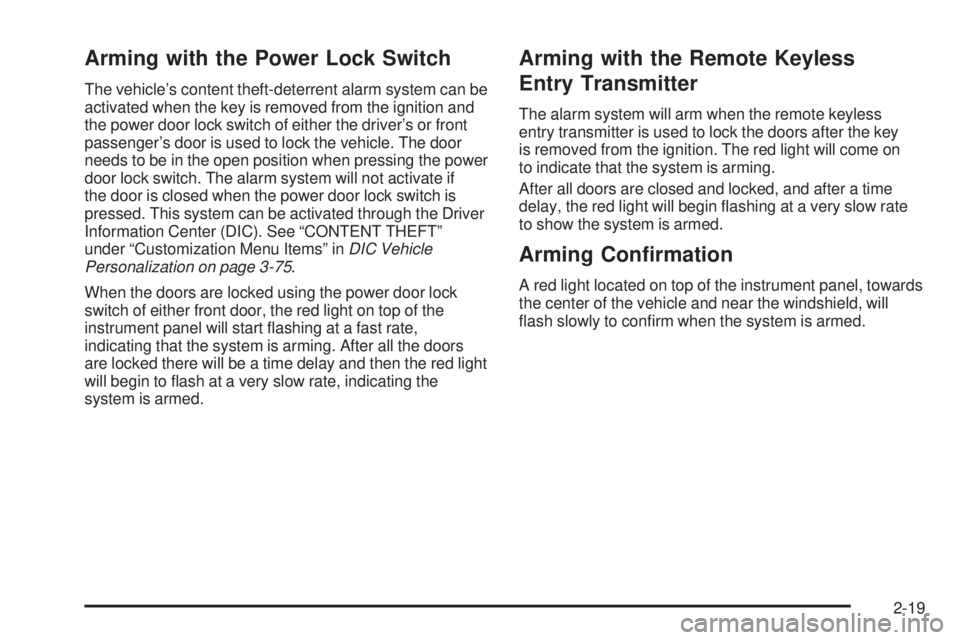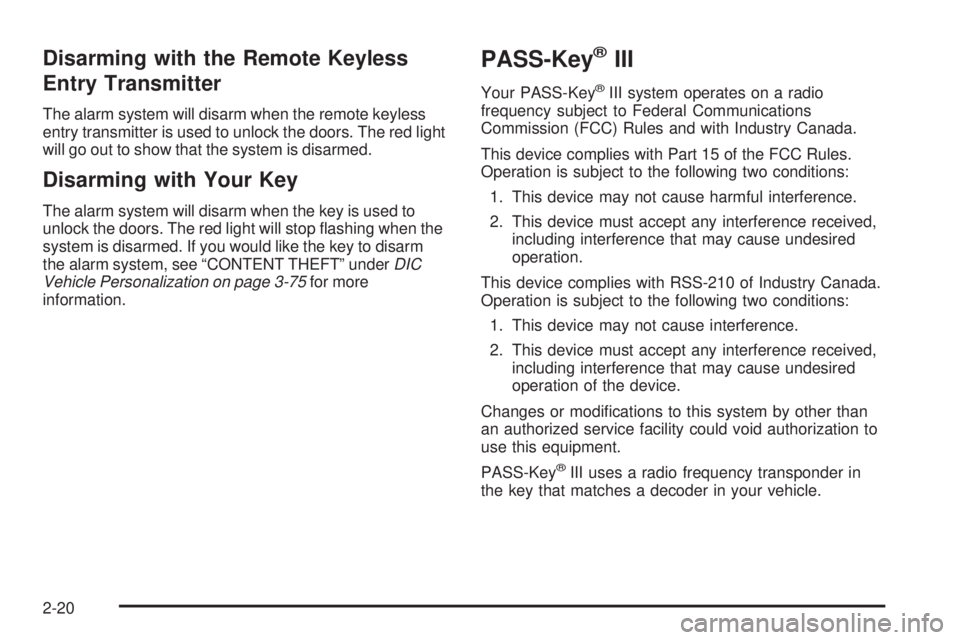Page 93 of 444

Emergency Trunk Release Handle
Notice:Do not use the emergency trunk release
handle as a tie-down or anchor point when securing
items in the trunk as it could damage the handle. The
emergency trunk release handle is only intended to
aid a person trapped in a latched trunk, enabling
them to open the trunk from the inside.
There is a glow-in-the-dark emergency trunk release
handle located on the trunk latch of the trunk lid.
This handle will glow following exposure to light.
If ever needed, pull the emergency trunk release
handle to open the trunk from the inside.
Trunk Lid Pull Down Handle and
Tie-Down Features
Your vehicle has a trunk lid pull down handle (A) located
on the inside of the trunk lid on the driver’s side of the
vehicle. Use the handle to pull down the trunk lid when
closing it.
Your vehicle also has a tie-down feature (B) located on
the inside the trunk lid on the passenger’s side of the
vehicle that can be used to secure the trunk lid when
large items are stored in the trunk.
2-15
Page 96 of 444

Sun Visors
To block out glare, swing down the sun visors. They can
be detached from the center retainer and slid along the
rod to cover different areas of the front window and
rotated to cover the side windows.
Visor Vanity Mirror
Swing down the sun visors and lift the cover to expose
the vanity mirror. Do not drive with the cover lifted due to
possible glare impeding other drivers behind or to the
side of the vehicle.
Theft-Deterrent Systems
Vehicle theft is big business, especially in some cities.
Although your vehicle has a number of theft-deterrent
features, we know that nothing we put on it can make it
impossible to steal.
Content Theft-Deterrent
Your vehicle may have a content theft-deterrent
alarm system.
A red light located on top
of the instrument panel,
toward the center of the
vehicle and near the
windshield, will �ash
slowly when the system
is armed.
The theft-deterrent alarm system needs to be activated
through the Driver Information Center (DIC). See
“CONTENT THEFT” under “Customization Menu Items”
inDIC Vehicle Personalization on page 3-75. While
armed, the doors will not unlock with the power door lock
switch. The remote alarm will sound if someone tampers
with the trunk or enters the vehicle without using the
remote keyless entry transmitter or key to unlock the
doors. The horn will sound and the headlamps will �ash
for up to two minutes. The system will also cut off the fuel
supply, preventing the vehicle from being driven.
2-18
Page 97 of 444

Arming with the Power Lock Switch
The vehicle’s content theft-deterrent alarm system can be
activated when the key is removed from the ignition and
the power door lock switch of either the driver’s or front
passenger’s door is used to lock the vehicle. The door
needs to be in the open position when pressing the power
door lock switch. The alarm system will not activate if
the door is closed when the power door lock switch is
pressed. This system can be activated through the Driver
Information Center (DIC). See “CONTENT THEFT”
under “Customization Menu Items” inDIC Vehicle
Personalization on page 3-75.
When the doors are locked using the power door lock
switch of either front door, the red light on top of the
instrument panel will start �ashing at a fast rate,
indicating that the system is arming. After all the doors
are locked there will be a time delay and then the red light
will begin to �ash at a very slow rate, indicating the
system is armed.
Arming with the Remote Keyless
Entry Transmitter
The alarm system will arm when the remote keyless
entry transmitter is used to lock the doors after the key
is removed from the ignition. The red light will come on
to indicate that the system is arming.
After all doors are closed and locked, and after a time
delay, the red light will begin �ashing at a very slow rate
to show the system is armed.
Arming Con�rmation
A red light located on top of the instrument panel, towards
the center of the vehicle and near the windshield, will
�ash slowly to con�rm when the system is armed.
2-19
Page 98 of 444

Disarming with the Remote Keyless
Entry Transmitter
The alarm system will disarm when the remote keyless
entry transmitter is used to unlock the doors. The red light
will go out to show that the system is disarmed.
Disarming with Your Key
The alarm system will disarm when the key is used to
unlock the doors. The red light will stop �ashing when the
system is disarmed. If you would like the key to disarm
the alarm system, see “CONTENT THEFT” underDIC
Vehicle Personalization on page 3-75for more
information.
PASS-Key®III
Your PASS-Key®III system operates on a radio
frequency subject to Federal Communications
Commission (FCC) Rules and with Industry Canada.
This device complies with Part 15 of the FCC Rules.
Operation is subject to the following two conditions:
1. This device may not cause harmful interference.
2. This device must accept any interference received,
including interference that may cause undesired
operation.
This device complies with RSS-210 of Industry Canada.
Operation is subject to the following two conditions:
1. This device may not cause interference.
2. This device must accept any interference received,
including interference that may cause undesired
operation of the device.
Changes or modi�cations to this system by other than
an authorized service facility could void authorization to
use this equipment.
PASS-Key
®III uses a radio frequency transponder in
the key that matches a decoder in your vehicle.
2-20
Page 101 of 444

Ignition Positions
With the ignition key in the ignition, the key can be
turned to four different positions:
Notice:Using a tool to force the key from the
ignition switch could cause damage or break the
key. Use the correct key and turn the key only with
your hand. Make sure the key is in all the way. If
none of this works, then your vehicle needs service.
A (OFF):This is the only position in which the ignition
key can be inserted or removed. This position locks
the ignition and transaxle. It is a theft-deterrent feature.B (ACCESSORY):This position lets the radio and
windshield wipers operate while the engine is off.
To use ACCESSORY, turn the key clockwise.
C (RUN):This position is where the key returns to after
the vehicle is started. This position displays some of the
warning and indicator lights.
D (START):This position starts the engine.
A warning chime will sound and the Driver Information
Center (DIC) will display DRIVER’S DOOR OPEN when
the driver’s door is opened if the ignition is in OFF,
ACCESSORY and the key is in the ignition. SeeDIC
Warnings and Messages on page 3-59for more
information.
Retained Accessory Power (RAP)
If the vehicle has Retained Accessory Power (RAP),
certain features will continue to operate for up to
10 minutes after the ignition key is turned to OFF
unless a door is opened.
2-23
Page 108 of 444

Parking Brake
To set the parking brake,
hold the regular brake
pedal down with your right
foot. Push down the
parking brake pedal with
your left foot.
To release the parking brake, hold the regular brake
pedal down with your right foot and push the parking
brake pedal with your left foot. While you lift your
left foot, the parking brake pedal will follow it to the
released position.A warning chime will sound and PARKING BRAKE ON
will display in the DIC if the parking brake is set, the
ignition is on, and the vehicle speed is greater than
5 mph (8 km/h). For more information seeBrake System
Warning Light on page 3-38andDIC Warnings and
Messages on page 3-59.
Notice:Driving with the parking brake on can
overheat the brake system and cause premature
wear or damage to brake system parts. Verify that
the parking brake is fully released and the brake
warning light is off before driving.
If you are towing a trailer and parking on any hill, see
Towing a Trailer on page 4-38. That section shows what
to do �rst to keep the trailer from moving.
2-30
Page 118 of 444

OnStar®Virtual Advisor
Your vehicle may have Virtual Advisor. It is a feature of
OnStar®Hands-Free Calling that uses your minutes to
access weather, local traffic reports, and stock quotes.
By pressing the phone button and giving a few simple
voice commands, you can browse through the various
topics. Customize your information pro�le at
www.myonstar.com. See the OnStar
®Owner’s Guide
for more information.
OnStar®Steering Wheel Controls
Your vehicle may be
equipped with a Talk/Mute
button that can be used to
interact with OnStar
®. See
the Audio Steering Wheel
Control section for your
speci�c vehicle operation.
When calling into voice mail systems, or to dial directory
numbers, press this button once, wait for the response,
say the number(s) to be dialed, wait for the number(s)
to be repeated and then say “dial”. See the OnStar
®
Owner’s Guide for more information.
Universal Home Remote
System
If your vehicle has this feature, the control buttons are
located on the driver’s sun visor.
The Universal Home Remote System provides a way
to replace up to three hand-held radio-frequency (RF)
transmitters used to activate devices such as gate
operators, garage door openers, entry door locks,
security systems, and home lighting.
2-40
Page 120 of 444

Be sure that people and objects are clear of the garage
door or gate operator you are programming. When
programming a garage door, it is advised to park outside
of the garage.
It is recommended that a new battery be installed in
your hand-held transmitter for quicker and more
accurate transmission of the radio-frequency signal.
Programming Universal Home Remote
Follow these steps to program up to three channels:
1. Press and hold down the two outside Universal
Home Remote buttons, releasing only when the
Universal Home Remote indicator light begins
to �ash, after 20 seconds. Do not hold down the
buttons for longer than 30 seconds and do not
repeat this step to program a second and/or third
hand-held transmitter to the remaining two Universal
Home Remote buttons.
2. Position the end of your hand-held transmitter
about 1 to 3 inches (3 to 8 cm) away from the
Universal Home Remote buttons while keeping the
indicator light in view.
3. Simultaneously press and hold both the desired
Universal Home Remote button and the hand-held
transmitter button. Do not release the buttons
until Step 4 has been completed.Some entry gates and garage door openers may
require you to substitute Step 3 with the procedure
noted in “Gate Operator and Canadian
Programming” later in this section.
4. The indicator light will �ash slowly at �rst and then
rapidly after Universal Home Remote successfully
receives the frequency signal from the hand-held
transmitter. Release both buttons.
5. Press and hold the newly-trained Universal Home
Remote button and observe the indicator light.
If the indicator light stays on constantly,
programming is complete and your device should
activate when the Universal Home Remote button is
pressed and released.
To program the remaining two Universal Home
Remote buttons, begin with Step 2 under
“Programming Universal Home Remote.” Do not
repeat Step 1 as this will erase all of the
programmed channels.
If the indicator light blinks rapidly for two seconds
and then turns to a constant light, continue with
Steps 6 through 8 following to complete the
programming of a rolling-code equipped device,
most commonly, a garage door opener.
2-42